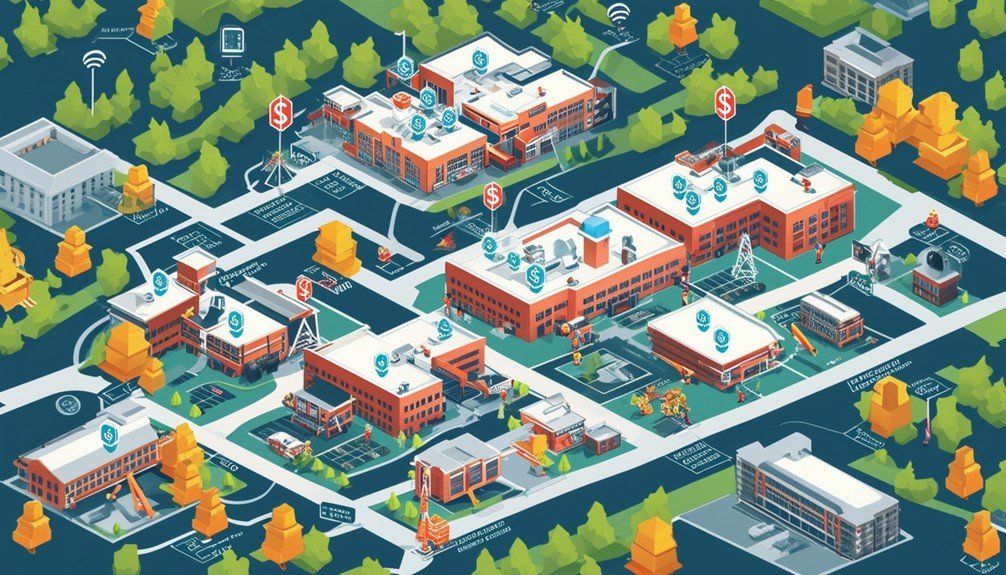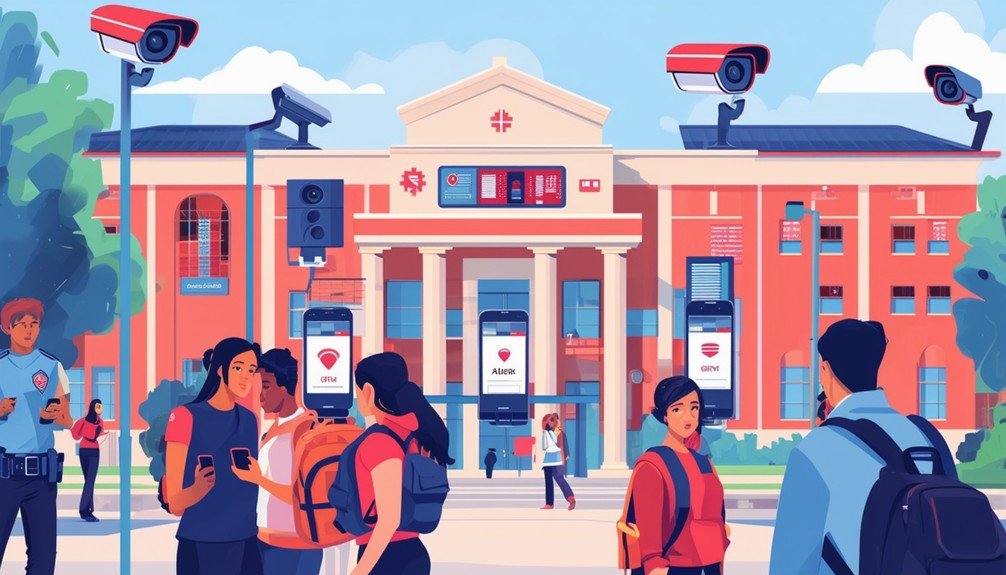Deploying advanced emergency alert systems on your college campus guarantees real-time communication and safety. Utilize wireless designs for flexibility and efficient deployment. Employ Algo IP Endpoints and speakers for clear auditory and visual notifications. Instant voice announcements offer immediate updates, while mobile app notifications improve reach and customization. Maintaining federal compliance through regular testing and documentation is crucial. Integrating audible and visual alerts enhances safety and emergency response effectiveness. Keep investigating to understand the wide-ranging benefits of implementing a robust emergency alert system on your campus.
Key Takeaways
- Advanced systems use wireless design for flexible, efficient deployment and real-time communication.
- Real-time voice announcements deliver clear, actionable updates during emergencies.
- Algo IP Endpoints and Speakers provide loud, clear audio and visual alerts for diverse campus settings.
- Mobile app notifications offer customizable alerts with panic buttons and strobe lights for enhanced safety.
- Compliance with legal requirements is crucial, involving regular testing, documentation, and panic button integration.
Overview of Emergency Notification Systems

Emergency notification systems in colleges consistently ensure real-time communication of important alerts to students, faculty, and staff. This system is necessary for guaranteeing the safety and security of everyone on campus during an emergency event. By leveraging both audible and visual notifications, the system guarantees that essential information reaches all individuals, regardless of their location or activity within the campus.
In an emergency event, the system’s capability to disseminate real-time alerts is pivotal. Audible notifications, such as sirens and announcements, can immediately draw attention, while visual notifications, including digital signage and text messages, provide clear instructions and updates. This dual approach maximizes the likelihood that all individuals are informed promptly and accurately.
Integration with advanced software enhances the system’s efficiency and scalability, allowing it to handle a wide range of emergency scenarios. This integration ensures that the system can quickly adapt to varying campus needs and conditions, providing a robust and reliable line of communication.
Key Features of Advanced Alert Systems

When evaluating advanced alert systems, you’ll find the wireless design offers significant benefits, including flexibility and ease of deployment. Additionally, real-time voice announcements enhance communication by delivering clear, immediate information to those in need. These features are critical for ensuring a timely and effective response during emergencies.
Wireless Design Benefits
How can advanced wireless design in alert systems transform campus safety and efficiency? Wireless design enhances the installation and relocation of emergency notification devices, making the alert system more adaptable to the changing needs of a college campus. With the ease of setup, institutions can promptly implement the system without extensive infrastructure changes, ensuring timely emergency responses.
Zone-specific alerts are a key feature, enabling targeted notifications to specific campus areas. This precision minimizes panic and confusion, directing live voice announcements and real-time instructions only to those who need them most. The ability to provide clear, immediate guidance greatly improves the effectiveness of emergency responses.
Remote device supervision further boosts reliability by allowing constant monitoring of all system components. Administrators can quickly identify and address any malfunctions or maintenance needs, ensuring top performance at all times. This oversight guarantees that every emergency notification will be delivered without fail.
Additionally, the flexibility for system expansion and device relocation offers scalability. As campuses grow or reconfigure, the alert system can seamlessly adapt, maintaining thorough coverage. This scalability supports long-term safety strategies, making wireless design an indispensable feature of advanced emergency alert systems.
Real-Time Voice Announcements
Real-time voice announcements in advanced alert systems promise immediate and clear communication during emergencies, greatly enhancing campus safety. When you rely on these systems, you guarantee that vital information is disseminated quickly and efficiently, reducing confusion and potential harm.
Here’s why real-time voice announcements are essential:
- Immediate Updates: Voice announcements provide instant updates, ensuring everyone is informed promptly.
- Customizable Messages: These systems allow you to tailor messages to specific emergency scenarios, enhancing communication clarity.
- Wide Reach: Utilizing speakers for emergency ensures that all individuals, regardless of their location on campus, can hear and respond to alerts.
- Enhanced Coordination: Real-time voice announcements streamline emergency response, fostering better coordination and overall safety.
Incorporating these features into your mass notification system means you can react promptly and efficiently during crises. Voice notifications cut through the noise, delivering clear and actionable directives. This immediacy is invaluable in emergencies, where every second counts. Additionally, the ability to customize messages helps address diverse situations with appropriate responses, making your alert system more versatile and effective.
Technical Benefits and Specifications

Algo IP Endpoints deliver unmatched auditory and visual alert solutions, guaranteeing immediate and efficient communication during emergencies in educational settings. These devices are essential for a complete range of notification solutions. An Algo IP speaker, for example, provides loud, clear audio that ensures emergency alerts are unmistakable. This clarity guarantees that everyone in the vicinity can easily identify the nature of the emergency, enhancing overall safety.
Algo’s visual alerts and displays complement the audio alerts, especially in noisy environments like playgrounds. These visual indicators guarantee that alerts are seen as well as heard, providing an extra layer of security. The integration of both audio and visual alerts ensures that critical information reaches all building occupants instantly, reducing response times and improving safety outcomes.
Algo IP Endpoints are designed to meet diverse emergency notification needs. They offer a versatile range of products, including various IP speakers, visual alerts, and displays, making them adaptable to different environments within a college setting. By utilizing these advanced technologies, colleges can build a strong emergency alert system that greatly enhances the safety and security of their educational communities.
Cost and Installation Insights

The Visiplex AlertWave™ system offers a budget-friendly and adaptable solution for installing emergency alert systems on college campuses. This cost-efficient wireless setup allows for easy relocation of speakers and LED boards, making it simple to expand the system as needed. With central transmitters providing effective notification coverage, you won’t have to worry about the size of your facilities.
Here’s why the Visiplex AlertWave™ system stands out:
- Cost-Efficient Installation: Wireless systems notably reduce installation costs compared to wired setups, eliminating the need for extensive cabling and professional installation.
- Ease of Expansion: The flexibility to relocate components like speakers and LED boards allows for scalable growth, adapting to any campus changes or expansions.
- Simplified Setup: The system’s straightforward installation process means you can quickly initiate emergency notifications without requiring specialized technical expertise.
- Comprehensive Coverage: High-power central transmitters ensure robust notification coverage across large areas, guaranteeing that emergency alerts reach every corner of your campus.
Enhancing Campus Safety and Communication

To improve campus safety and communication, integrating audible and visual emergency alerts guarantees that all individuals receive timely and clear notifications during important situations. Algo IP Endpoints offer highly noticeable solutions, making sure that emergency alerting is both effective and immediate. These endpoints seamlessly incorporate Algo IP Speakers and visual alerts, creating a robust and detailed notification system.
Algo IP Speakers deliver loud, clear audio for easy identification of emergency alerts, making them suitable for both indoor and outdoor environments. Their ability to broadcast pre-recorded notifications ensures that messages are consistent and easily understood. Complementing these speakers, visual alerts like the 8128 IP Visual Alerter and 8138 IP Color Visual Alerter provide customizable flash patterns to draw attention even in noisy or visually cluttered spaces. These visual cues are essential for individuals with hearing impairments and enhance overall situational awareness.
Integrating panic buttons into the system allows for immediate, user-initiated alerts, ensuring quick responses to emerging threats. Combining these elements, Algo IP Endpoints create a multi-dimensional emergency alerting system that greatly enhances campus safety and communication efficiency.
Types of Emergency Notifications

When considering emergency alert systems for colleges, you’ll find SMS and email alerts, as well as mobile app notifications, to be essential tools. These methods guarantee rapid dissemination of information, providing instant updates to students and staff. By leveraging these notification types, you can enhance campus safety and improve emergency response coordination effectively.
SMS and Email Alerts
SMS and email alerts serve as crucial tools for swiftly disseminating emergency information to every member of the college community. These methods are essential to effective emergency management, ensuring that essential updates reach students, faculty, and staff without delay. SMS texts, in particular, are invaluable due to their immediacy and high open rates.
Here’s why SMS and email alerts are irreplaceable:
- Speed and Efficiency: SMS texts are delivered almost instantaneously, allowing for rapid communication during emergencies. Emails, while slightly slower, can provide more detailed information.
- Wide Reach: Unlike wall-mounted devices or speakers designed for specific locations, SMS and email alerts can reach individuals wherever they are, on or off campus.
- Versatility: These alerts can convey a range of information, from severe weather warnings and campus closures to active threats and safety instructions.
- Accessibility: Almost everyone has access to a mobile phone or computer, making SMS and email a highly inclusive method of communication.
Mobile App Notifications
Mobile app notifications, covering text messages, push notifications, and in-app alerts, form an essential component of modern emergency communication strategies for colleges. They guarantee that students, faculty, and staff receive real-time updates directly on their smartphones, enhancing campus safety significantly.
By integrating these mobile alerts into your emergency system, you can customize notifications to target specific groups or individuals based on their location or role. This targeted approach means that the right people get the right information at the right time. Additionally, many apps come equipped with features like panic buttons, voice messages, and even strobe lights, which can be vital during high-stress situations.
Here’s a comparison of key mobile app notification features:
| Feature | Description | Benefit |
|---|---|---|
| Text Messages | Direct SMS to smartphones | Immediate alert delivery |
| Push Notifications | Notifications displayed on device screens | High visibility |
| In-App Alerts | Notifications within the app interface | Centralized information source |
Effective use of mobile app notifications ensures a complete communication strategy. The inclusion of panic buttons allows users to signal distress instantly, while voice messages can convey urgent information clearly. Strobe lights can serve as visual alerts in noisy environments. By leveraging these tools, you can foster a safer, more responsive campus environment.
Compliance and Legal Requirements

To ensure compliance with federal and state regulations, colleges must implement robust emergency alert systems that can rapidly disseminate information across the entire campus. These systems are designed to meet the specific criteria outlined in laws such as the Clery Act and Title IX. Key elements include panic buttons to initiate alerts, guaranteeing immediate action during emergencies. Such systems provide the right level of responsiveness, offering an effective means to keep everyone informed and safe.
Failure to comply with these legal requirements can lead to significant fines and reputational damage. Hence, it’s vital to understand the compliance landscape. Here are key steps to make sure your college meets legal obligations:
- System Implementation: Install an emergency alert system that covers the entire campus, making certain it meets all federal and state guidelines.
- Regular Testing: Conduct routine tests of the system to confirm functionality and reliability. Document all tests meticulously.
- Panic Buttons: Integrate panic buttons that can trigger alerts instantly, ensuring swift communication during emergencies.
- Documentation and Reporting: Maintain detailed records of all alerts and system tests to demonstrate compliance during audits.
Conclusion
Investing in advanced emergency alert systems for colleges isn’t just a smart move; it’s a lifesaver. These systems, with cutting-edge features and seamless integration, are your campus’s silent guardians, ready to spring into action at a moment’s notice. By enhancing safety and ensuring compliance, they form an unbreakable shield around your community. Don’t wait until the storm hits—fortify your campus today and rest easy knowing you’re prepared for any emergency.
Frequently Asked Questions
What Is the Best School Alert System?
The top school alert system offers instant alerts, integrates with existing security, and features customizable panic buttons. It includes GPS tracking for precise locations and two-way communication for effective crisis management. Guarantee these features for maximum safety.
What Is a Raptor Alert in School?
A Raptor Alert in school works like a lifeline, ensuring rapid responses during emergencies. You can initiate silent panic alerts, activate emergency mechanisms, and communicate in real-time, enhancing safety with seamless integration and critical information sharing.
How Does IPAWS Work?
So, you want to know how IPAWS works? Imagine a bureaucratic superhero. Authorized officials send emergency alerts through multiple channels like WEA and NOAA Weather Radio, ensuring you get the same warning across all platforms. Efficient, huh?





